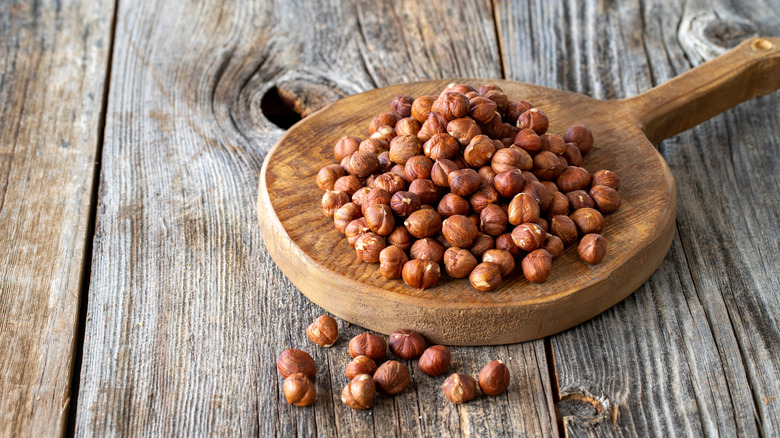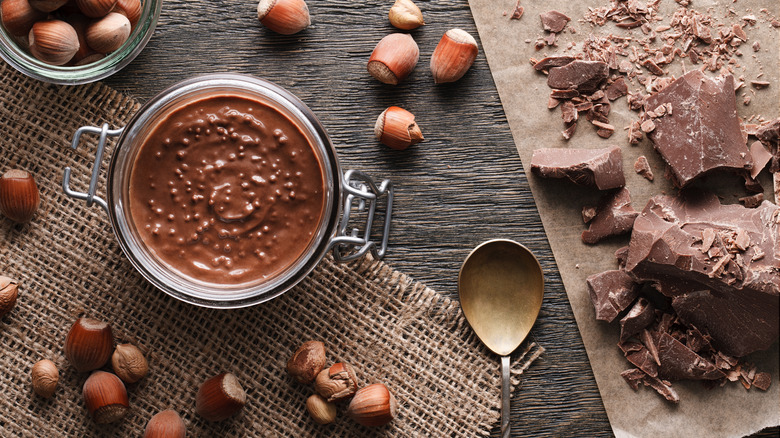What Makes Italy's Gianduja Chocolate Unique
Many of us might consider Italian food to be one cuisine, yet it is so much more than that. The country is made up of 20 regions — from Lombardy and Piemonte in the north to Liguria, Emilia-Romagna and Tuscany in the center, and Calabria and Sicily in the south, per Italofile, each with its own unique landscape. Small wonder then, as Anthony Bourdain points out for CNN, that in Italy, "Even the basics differ — pasta with or without egg, butter in abundance or ditched completely in favor of olive oil. Like reading tea leaves, travelers can discover much about a region's history and landscape from its special sauce."
The northern region of Piemonte, or Piedmont, is the country's second-largest. It's known for its wines: Barolo, Barbaresco, and Barbera d'Asti; cheeses like Castelmagno; and region-specific pasta styles like the tajarin and agnolotti del plin, as well as the rare, prized Alba white truffle, per Great Italian Chefs. It's also home to the region's prized hazelnuts which are grown in the wine-growing regions of Langhe, Roero, and Monferrato and which are protected under the EU's strict PGI (protected geographical indication) designation. Piedmont's hazelnuts, which are described as being smaller and sweeter than hazelnuts found elsewhere, are used to make gianduja — making this culinary marriage of chocolate and hazelnut unique to the region.
Gianduja was invented out of necessity
It can be said that gianduja was born out of necessity. Chocolate first arrived in Italy in the 1700s as a drink before Piedmont's craftsmen realized they could turn liquid chocolate into solid blocks. It was a discovery that would turn Piedmont's capital city, Turin, into a chocolate-making hub, but it also made Turin vulnerable to geopolitics. A blockade imposed by Napoleon Bonaparte on goods coming from Britain and its territories dried up cocoa supplies in the early 1800s, forcing Turin's chocolatiers to get creative and find cocoa enhancers or go under, per Eataly.
It is here that the narrative diverges somewhat. Eataly says strict cocoa rationing and high import taxes eventually saw famed chocolatier Pier Paul Caffarel blend Piedmont's unique hazelnuts with cocoa in the 1860s to make what is now known as gianduja.
But Great Italian Chefs says local confectioners first came up with the idea of grinding down local hazelnuts into a paste to enrich what little cocoa they had in 1806. Still, the technique wasn't perfected until 1852, when Michele Prochet and Paul Caffarel's son Isidore decided to roast the hazelnuts and add almonds. The new chocolate made its debut in 1865 during Carnival, and they were distributed by men masquerading as Gianduja, a Piedmontese peasant and a character in traditional Italian theatre, per Eataly.
Gianduja gave rise to Nutella
The trio of chocolate, hazelnut, and sugar didn't just give rise to one of the world's first solid chocolate and nut candies, per The Vintage News. Another spike in cocoa prices and tightening of cocoa supplies would impact Piedmont's chocolatiers again during the Second World War. This time, it would be pastry maker Pietro Ferrero who would turn to the region's hazelnut paste as a solution, and he created Pasta Gianduja, a loaf of chocolate and hazelnut paste that could be sliced and served on bread. Ferrero followed that up with a second product called "Suprecrema Gianduja," which came in a jar and could be scooped out with a spoon and spread on just about anything. That chocolate and hazelnut spread was revived in 1963 by Ferrero's son Michele and rechristened "Nutella."
In order to be considered "traditional" gianduja, 30% of the chocolate nut spread needs to be made with hazelnuts, and the original gianduja is considered a Piedmont specialty. It is not only made into a chocolate hazelnut spread but gianduja is also known as the chocolate candy shaped like an inverted boat and wrapped in gold-colored wrap per Italian Traditions. Piedmontese cooks also make a chocolate hazelnut cake they call "torta gianduja" per Italian Notes, although it doesn't necessarily make use of the centuries-old paste which saved the region's chocolate-making business.


